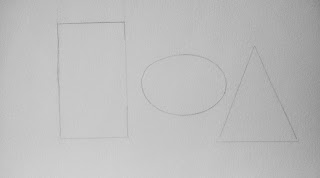ONE LAYER PAINTING
Here is the photo reference. This was taken by my son-in-law on one of his motorcycle trips, I think through Virginia. I was attracted by the cloud shapes and the feeling of mountains receding in the distance.
So you don't have to scroll through for the web sites, I will go ahead and put them here. They are 2 youtubes by Angela Fehr, a loose watercolor painter. Each one is about 30 minutes, but have a lot of information and are entertaining to watch.
I didn't draw much, just indicated generally where the hills were and parts of the clouds and the horizon line.
Before painting, I spattered some miskit along the foreground for the white flowers. Dry.
Then I started painting the clouds. I got the top 1/3 of the paper wet and started applying my sky/cloud colors. I used cobalt blue, some Janet's Violet, and a bit of Ultramarine Turquoise. When painting wet into wet, you have to remember this will dry much lighter. Since I was trying to do as much as possible in one layer, I applied it pretty dark, and this is how light it dried.
After I had the very top the way I wanted it, I wet the lower half of the clouds, and began painting them in. As long as the paper is wet, I will not get hard lines, and I can play with the clouds a long time.
While waiting for the sky to dry, I painted the layer of hills that is mid blue.(shown behind the green hill) I skipped the green hill while that dried, and did the dark green hill nearest the foreground.
I used green apatite genuine with ultramarine turquoise, pretty dark, leaving the bottom wet.
USING A HOG BRISTLE BRUSH (the cheap kind you get in packages from Walmart), I lightly brushed the dark paint into the white on the bottom to create grass in that next layer.
After that was dry, I painted in the blue green hill behind the dark one.
I finished working in the rows of hills behind the blue ones. Each successive row gets small, cooler,
grayer, and less distinct. My color choices were:
Dark green hill: ultramrine turquoise and green apatite genuine
Middle green/blue hill: Ultramarine turquoise with less green and some cobalt blue
Blue hill: mostly cobalt with a hint of turquoise
Next layer: cobalt with a bit of violet
Last layer: mostly violet
FOREGROUND: I used some quin gold underneath, and added some green apatite genuine and turquoise. Then I removed the miskit.
When I got home I only added a few touches. I put in a tree on the right and some tall grasses. I added some red/violet to some of the whites for a pop of color.
Below is the first time I tried this painting. It turned out paler, but I still liked it. What I changed were some of the colors I used, because the violet and blue I used first in the sky turned out to be granulating. I also wanted to raise the foreground a little in the picture.
A side by side comparison.




















